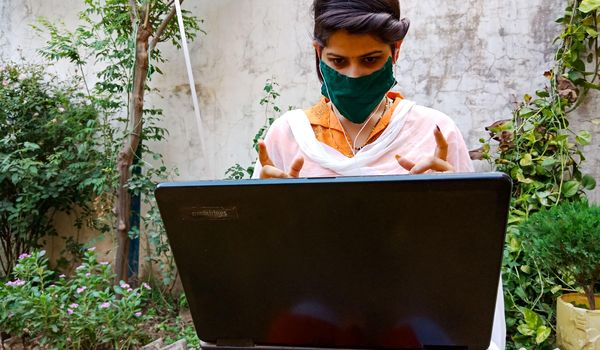Due to the COVID-19 crisis and the restrictive measures taken globally, violence against women and girls seems to have increased. Women's rights groups and victims support groups reported a rise of domestic violence and dramatic effects on sexual and reproductive rights of women and girls. The extremely stressful situation people felt during the lockdown periods, the widening gap between men and women related to care work, the restrictions on asking for help, and many other negative gender-related circumstances led to an increase of calls for help. Yet, another aspect of the crisis is still under-reported and official data is lacking: The effects of COVID-19 on cyber violence against girls and women are still under investigation.
According to the Forbes magazine, the lock-down and social distancing policies have increased the use of the Internet between 50 % to 70 %, being used for work, school, university, shopping etc. Usually, users with limited digital skills seem to be more at risk of cyber violence. Given the digital gender divide, women and girls are at a higher risk for these forms of violence. According to UN Women, particularly, female human rights activists, politicians, journalists, bloggers, members of ethnic minorities, indigenous women, LBTIQ+ persons, and women with disabilities are often experiencing online threads and harassment. The imposed lockdown created a “gender emergency” in several countries, by increasing the exposure of women to gender-based violence, including online violence. Google reported an 75 % increase in internet searches relating to support for different forms of violence. Reports by several EU countries state that the pandemic was used by perpetrators as a coercive control mechanism for the containment, fear, threat, and victimization of women at any form (physical or digital).
On the other hand, safe, affordable, and inclusive digital tools could increase the participation of girls and women and reduce the gender digital divide and cyber violence. The CYBERSAFE Project, which Women Against Violence Europe (WAVE) and partner organizations from eight EU countries are implementing, is one of such projects to tackle cyber violence.
Cyber violence: Forms, impact, and perceptions

The United Nations Declaration on the Elimination of Violence against Women (1993) defines violence against women (VAW) as “any act of gender-based violence that results in, or is likely to result in, physical, sexual or psychological harm or suffering to women, including threats of such acts, coercion or arbitrary deprivation of liberty, whether occurring in public or private life. In the last decade, the rise of technological advancement as a popular mode of socialization has extended gender-based violence to a new dimension. As a result, young women negotiate the digital world both as a site of empowerment and a source of sexual repression.
Cyber violence against women and girls is gender-based violence that is perpetrated through electronic communication and the Internet. There are various forms, including, but not limited to, cyber stalking, non-consensual pornography (or ‘revenge porn’), gender-based slurs, hate speech and harassment, ‘slut-shaming’, unsolicited pornography, ‘sextortion’, rape threats and death threats, and electronically facilitated trafficking. Although cyber violence can affect both women and men, women and girls experience it more often and more traumatic forms of cyber violence. The European Institute for Gender Equality (EIGE) notes that one in ten women older than 15 years, experiences cyber violence. A 2014 FRA study even showed that between 5 % and 18 % of women in the EU have already experienced cyber violence. This proportion is even higher among adolescents.
Online sexual harassment can include a wide range of behaviours that use digital content (images, videos, posts, messages, pages) on a variety of different online platforms (private or public). Victims and perpetrators may be numerous. As research shows, victims mainly know their perpetrator(s). Online sexual harassment is often happening around schools and local communities and often happens in front of an active audience which might add to the distress caused. Bystanders can also be affected by witnessing online sexual harassment regardless of whether they engage with it or not.
One challenge is that cyber violence is not always recognized by the victim nor by the perpetrator. Further, it seems to be tolerated, especially by boys, who may see cyber violence as fun and not as a harmful behaviour. Recent research by the CYBERVAW Project conducted in Slovenia in 2018 has revealed several reasons for the occurrence of cyber violence. Most persistent reasons for cyber violence mentioned were the following: “it was a joke”, “for fun”, “to hurt someone“, “because someone did it to me“, “to get back at an ex“, “to get respect from friends“, “I was scared not to participate”. Further, there is a strong sense of victim-blaming attitudes among teenagers. Gender stereotypes among teenagers, that seem to be deeply rooted, contribute to cyber violence. For instance, the study at the school communities in Slovenia, showed that 54 % of boys and 42 % of girls agree that girls posting their photos on the Internet, are to blame for being harassed.
The CYBERSAFE Project

The CYBEERSAFE Project is an attempt to address cyber violence among youths in eight European countries, and is led by the Union of Women Associations of Heraklion (Greece). Several focus group discussions in four countries (Italy, Greece, UK, Estonia) were conducted and problematic behaviours were identified: A high tolerance of cyber violence among youths, the lack of recognition of cyber violence, the blaming of victims, not perceiving the perpetrator(s) as being responsible, the hesitancy of seeking support, the silence of bystanders, and rooted gender stereotypes. The research findings have also revealed that cyber violence is rising among youths. However, these early findings remain to be validated through further studies. However, the need to organise a “safety plan” towards cyber violence within school communities seems urgent. In order to support students and teachers, an innovative educational ICT tool (CYBERSAFE Toolkit) facilitating behavioural change among teenagers related to cyber violence will be developed. The CYBERSAFE Toolkit will addresses four forms of cyber violence against girls: Non-consensual sharing of sexual images (and videos), exploitation, coercion and threats, sexualised bullying and unwanted sexualisation. Students should develop the capacity to: recognise (signs of) online violence against girls; understand the emotional impact and other possible consequences of cyber violence; know how to prevent online violence against girls; know how to act in an adequate, supportive and positive way if they themselves or someone else experiences online violence.
The phenomenon of violence among youths on the Internet is an increasing and constantly changing phenomenon. During the COVID-19 pandemic we have seen a rise of incidents all over Europe. The provision of online tools on awareness, and the urge to publicly discuss and report incidents prevail a priority (22 September 2020).

